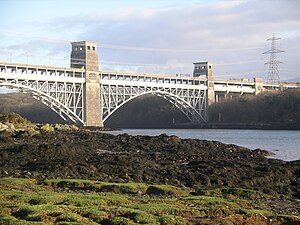
Back جسر بريتانيا Arabic كوبرى بريتانيا ARZ Pont Britannia Breton Britannia Bridge Czech Pont Britannia Welsh Britanniabrücke German Ponto Britannia Esperanto Puente Britannia Spanish Britannia sild Estonian Britannia zubia Basque
Britannia Bridge Pont Britannia | |
|---|---|
 The modern Britannia Bridge. | |
| Coordinates | 53°12′59″N 4°11′9″W / 53.21639°N 4.18583°W |
| Carried | North Wales Coast Line |
| Crossed | Menai Strait |
| Locale | Anglesey, North Wales |
| Characteristics | |
| Design | Tubular bridge (first bridge) Two-tier truss arch bridge (second bridge) |
| Material | Wrought iron and stone (first bridge) Steel and concrete (second bridge) |
| Total length | 1,510.25 ft (460.32 m)[1] |
| Height | 221.25 ft (67.44 m)[1] to top of centre tower |
| Longest span | 460 ft (140 m)[1] |
| No. of spans | Four |
| Piers in water | One |
| Clearance above | 103 ft (31 m)[1] to bottom of rail deck |
| History | |
| Designer | Robert Stephenson |
| Construction start | 1846 (first bridge) 1972 (second bridge) |
| Construction end | 1850 (first bridge) 1980 (second bridge) |
| Opened | 1850 (rail, first bridge) 1974 (rail, second bridge) 1980 (road, second bridge) |
| Destroyed | May 23, 1970 (first bridge) |
| Closed | 1974 (first bridge) |
| Location | |
 | |
Britannia Bridge (Welsh: Pont Britannia) is a bridge in Wales that crosses the Menai Strait between the Isle of Anglesey and city of Bangor. It was originally designed and built by the noted railway engineer Robert Stephenson as a tubular bridge of wrought iron rectangular box-section spans for carrying rail traffic. Its importance was to form a critical link of the Chester and Holyhead Railway's route, enabling trains to directly travel between London and the port of Holyhead, thus facilitating a sea link to Dublin, Ireland.[2]
Decades before the building of the Britannia Bridge, the Menai Suspension Bridge had been completed, but this structure carried a road rather than track; there was no rail connection to Anglesey before its construction. After many years of deliberation and proposals, on 30 June 1845, a Parliamentary Bill covering the construction of the Britannia Bridge received royal assent.[3] At the Admiralty's insistence, the bridge elements were required to be relatively high in order to permit the passage of a fully rigged man-of-war. In order to meet the diverse requirements, Stephenson, the project's chief engineer, performed in-depth studies on the concept of tubular bridges. For the detailed design of the structure's girders, Stephenson gained the assistance of distinguished engineer William Fairbairn. On 10 April 1846, the foundation stone for the Britannia Bridge was laid. The construction method used for the riveted wrought iron tubes was derived from contemporary shipbuilding practices; the same technique as used for the Britannia Bridge was also used on the smaller Conwy Railway Bridge. On 5 March 1850, Stephenson himself fitted the last rivet of the structure, marking the bridge's official completion.
On 3 March 1966, the Britannia Bridge received Grade II listed status.[4]
A fire in May 1970 caused extensive damage to the Britannia Bridge. Subsequent investigation determined that the damage to the tubes was so extensive that they were not realistically repairable. The bridge was rebuilt in a quite different configuration, reusing the piers while employing new arches to support not one but two decks, as the new Britannia Bridge was to function as a combined road-and-rail bridge. The bridge was rebuilt in phases, initially reopening in 1972 as a single-tier steel truss arch bridge, carrying only rail traffic. Over the next eight years more of the structure was replaced, allowing for more trains to run and a second tier to be completed. The second tier was opened to accommodate road traffic in 1980. The bridge was subject to a £4 million four-month in-depth maintenance programme during 2011. Since the 1990s, there has been talk of increasing road capacity over the Menai Strait, either by extending the road deck of the existing bridge or via the construction of a third bridge.
- ^ a b c d Clark, Edwin (1850). The Britannia and Conway tubular bridges With general inquires on beams and on the properties of materials used in construction, Vol. 2. Day & Son. pp. 540, 545, 585, 587.
- ^ Cite error: The named reference
TC, Dreicerwas invoked but never defined (see the help page). - ^ Cite error: The named reference
eng timewas invoked but never defined (see the help page). - ^ CADW Summary Description of a Listed Building https://cadwpublic-api.azurewebsites.net/reports/listedbuilding/FullReport?lang=&id=3674
© MMXXIII Rich X Search. We shall prevail. All rights reserved. Rich X Search